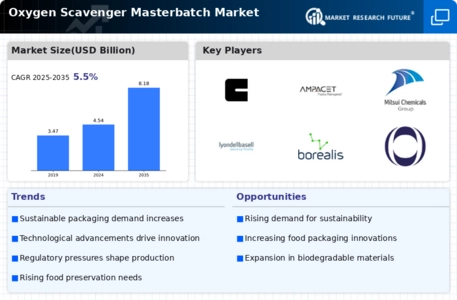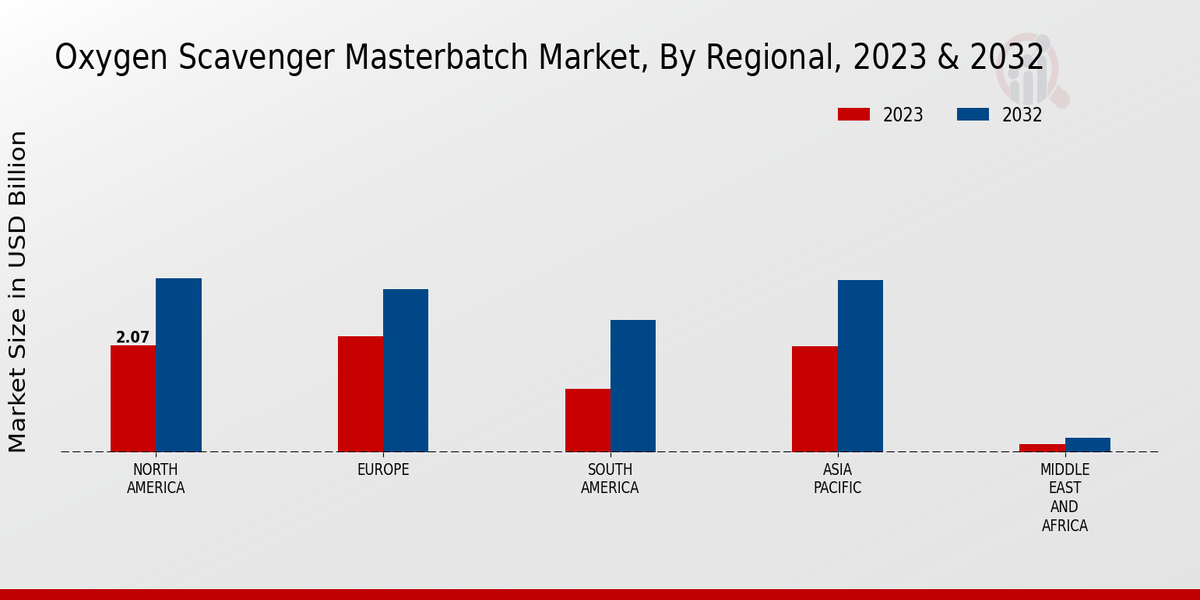Market Growth Projections
The Global Oxygen Scavenger Masterbatch Market Industry is projected to experience substantial growth in the coming years. With a market value of 4.54 USD Billion in 2024, it is anticipated to reach 8.18 USD Billion by 2035, reflecting a robust CAGR of 5.49% from 2025 to 2035. This growth trajectory indicates a strong demand for oxygen scavenger masterbatches across various applications, including food packaging, pharmaceuticals, and consumer goods. As industries increasingly recognize the benefits of oxygen scavenging technology, the market is likely to expand, driven by innovations and evolving consumer preferences.
Growth in Packaging Industry
The Global Oxygen Scavenger Masterbatch Market Industry is significantly influenced by the expansion of the packaging sector. With the rise of e-commerce and retail, there is an increasing demand for innovative packaging solutions that ensure product integrity during transit and storage. Oxygen scavenger masterbatches are utilized in various packaging materials, including films and containers, to protect products from oxidation. This trend is expected to contribute to a compound annual growth rate (CAGR) of 5.49% from 2025 to 2035. As companies seek to enhance their packaging offerings, the integration of oxygen scavengers becomes a strategic priority, further driving market growth.
Expansion of the Beverage Industry
The expansion of the beverage industry significantly impacts the Global Oxygen Scavenger Masterbatch Market Industry. With the rising consumption of bottled beverages, there is an increasing need for packaging solutions that prevent oxidation and maintain product quality. Oxygen scavenger masterbatches are essential in preserving the taste and freshness of beverages, particularly in sensitive products like juices and carbonated drinks. As the beverage sector continues to grow, the demand for effective oxygen scavenging solutions is expected to rise, further driving market growth. This trend underscores the importance of oxygen scavengers in ensuring the quality and safety of beverage products.
Rising Demand for Food Preservation
The Global Oxygen Scavenger Masterbatch Market Industry experiences a notable surge in demand driven by the increasing need for food preservation. As consumers become more health-conscious, the requirement for longer shelf life and enhanced quality in food products intensifies. Oxygen scavengers play a critical role in extending the freshness of packaged foods, thereby reducing waste. In 2024, the market is projected to reach 4.54 USD Billion, reflecting the growing awareness of food safety and quality. This trend is likely to continue, as the industry adapts to consumer preferences and regulatory standards, ensuring that oxygen scavenger masterbatches remain integral to food packaging solutions.
Increasing Awareness of Sustainability
Sustainability concerns are becoming increasingly prominent within the Global Oxygen Scavenger Masterbatch Market Industry. As environmental regulations tighten and consumer preferences shift towards eco-friendly products, manufacturers are compelled to adopt sustainable practices. Oxygen scavenger masterbatches can contribute to reducing food waste and enhancing recyclability in packaging materials. This alignment with sustainability goals not only meets regulatory requirements but also appeals to environmentally conscious consumers. Consequently, the market is likely to witness growth as companies invest in sustainable packaging solutions that incorporate oxygen scavengers, thereby enhancing their market positioning.
Technological Advancements in Masterbatch Production
Technological advancements in the production of oxygen scavenger masterbatches are shaping the Global Oxygen Scavenger Masterbatch Market Industry. Innovations in polymer chemistry and processing techniques have led to the development of more efficient and effective scavenger formulations. These advancements not only improve the performance of masterbatches but also reduce production costs, making them more accessible to manufacturers. As a result, the market is poised for growth, with projections indicating a rise to 8.18 USD Billion by 2035. The continuous evolution of production technologies ensures that the industry remains competitive and responsive to changing market demands.



 Source: Primary Research, Secondary Research, MRFR Database and Analyst Review
Source: Primary Research, Secondary Research, MRFR Database and Analyst Review
















